Key Sources of Laws for Business Organizations in the UK
VerifiedAdded on 2023/06/10
|9
|2589
|256
AI Summary
This report describes the legal context for business organizations in the UK and the different types of business structures such as sole trader, partnership, and limited liability. It also provides recommendations for IOM Solutions to enhance its business operations. Subject: Business Management, Course Code: BMP4002 Business Law, College/University: Not mentioned
Contribute Materials
Your contribution can guide someone’s learning journey. Share your
documents today.
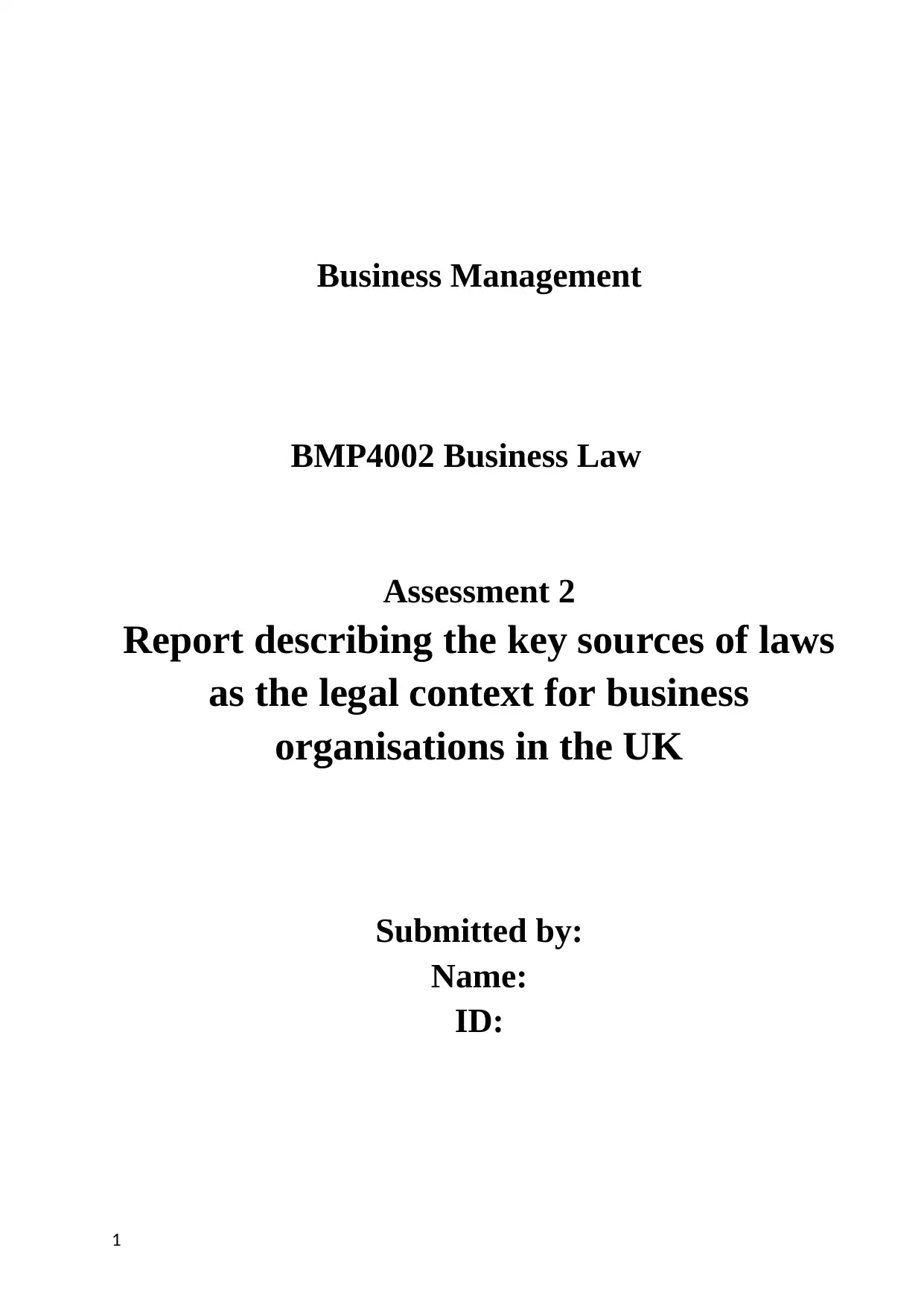
Business Management
BMP4002 Business Law
Assessment 2
Report describing the key sources of laws
as the legal context for business
organisations in the UK
Submitted by:
Name:
ID:
1
BMP4002 Business Law
Assessment 2
Report describing the key sources of laws
as the legal context for business
organisations in the UK
Submitted by:
Name:
ID:
1
Secure Best Marks with AI Grader
Need help grading? Try our AI Grader for instant feedback on your assignments.
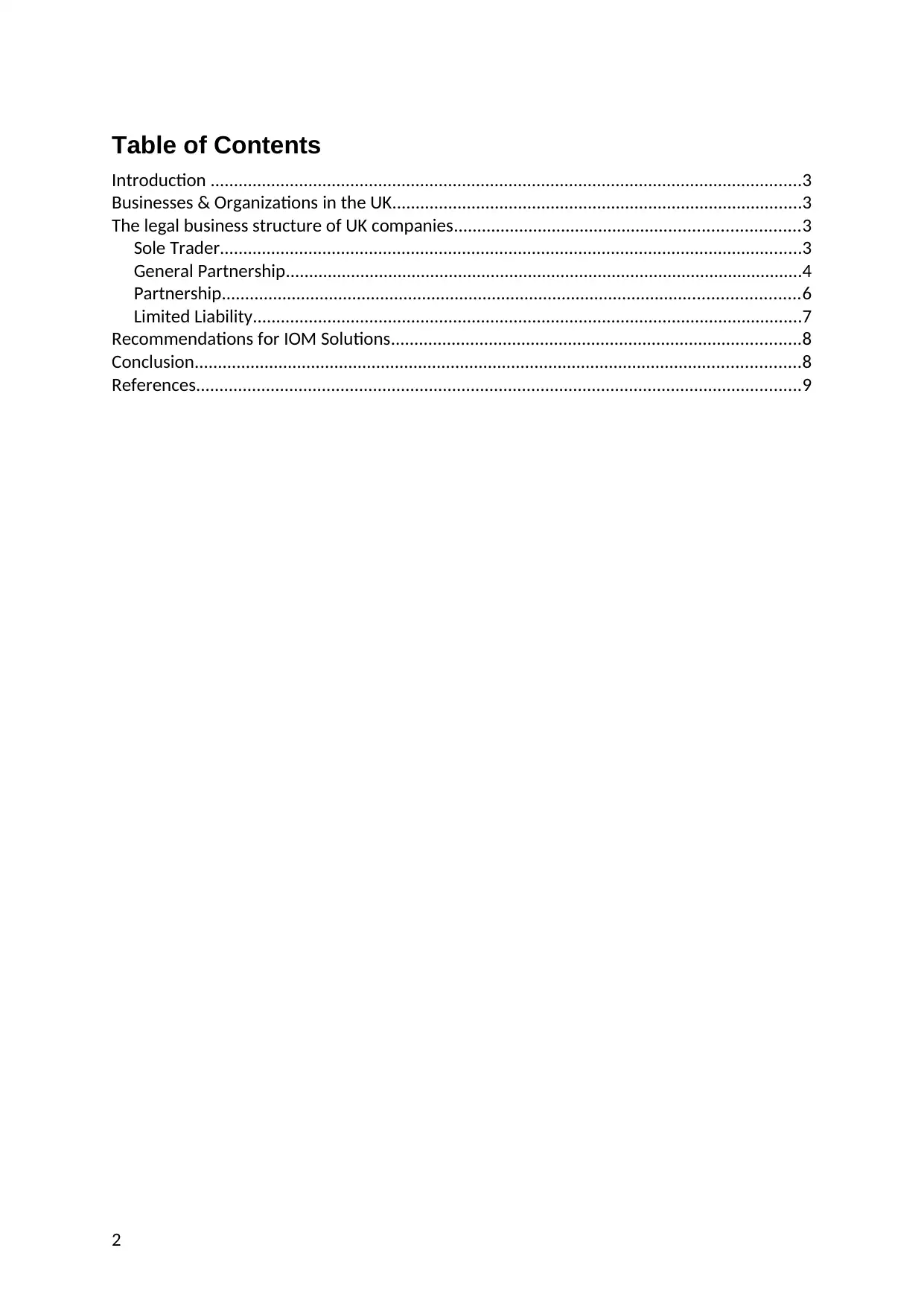
Table of Contents
Introduction ...............................................................................................................................3
Businesses & Organizations in the UK........................................................................................3
The legal business structure of UK companies..........................................................................3
Sole Trader.............................................................................................................................3
General Partnership...............................................................................................................4
Partnership............................................................................................................................6
Limited Liability......................................................................................................................7
Recommendations for IOM Solutions........................................................................................8
Conclusion..................................................................................................................................8
References..................................................................................................................................9
2
Introduction ...............................................................................................................................3
Businesses & Organizations in the UK........................................................................................3
The legal business structure of UK companies..........................................................................3
Sole Trader.............................................................................................................................3
General Partnership...............................................................................................................4
Partnership............................................................................................................................6
Limited Liability......................................................................................................................7
Recommendations for IOM Solutions........................................................................................8
Conclusion..................................................................................................................................8
References..................................................................................................................................9
2
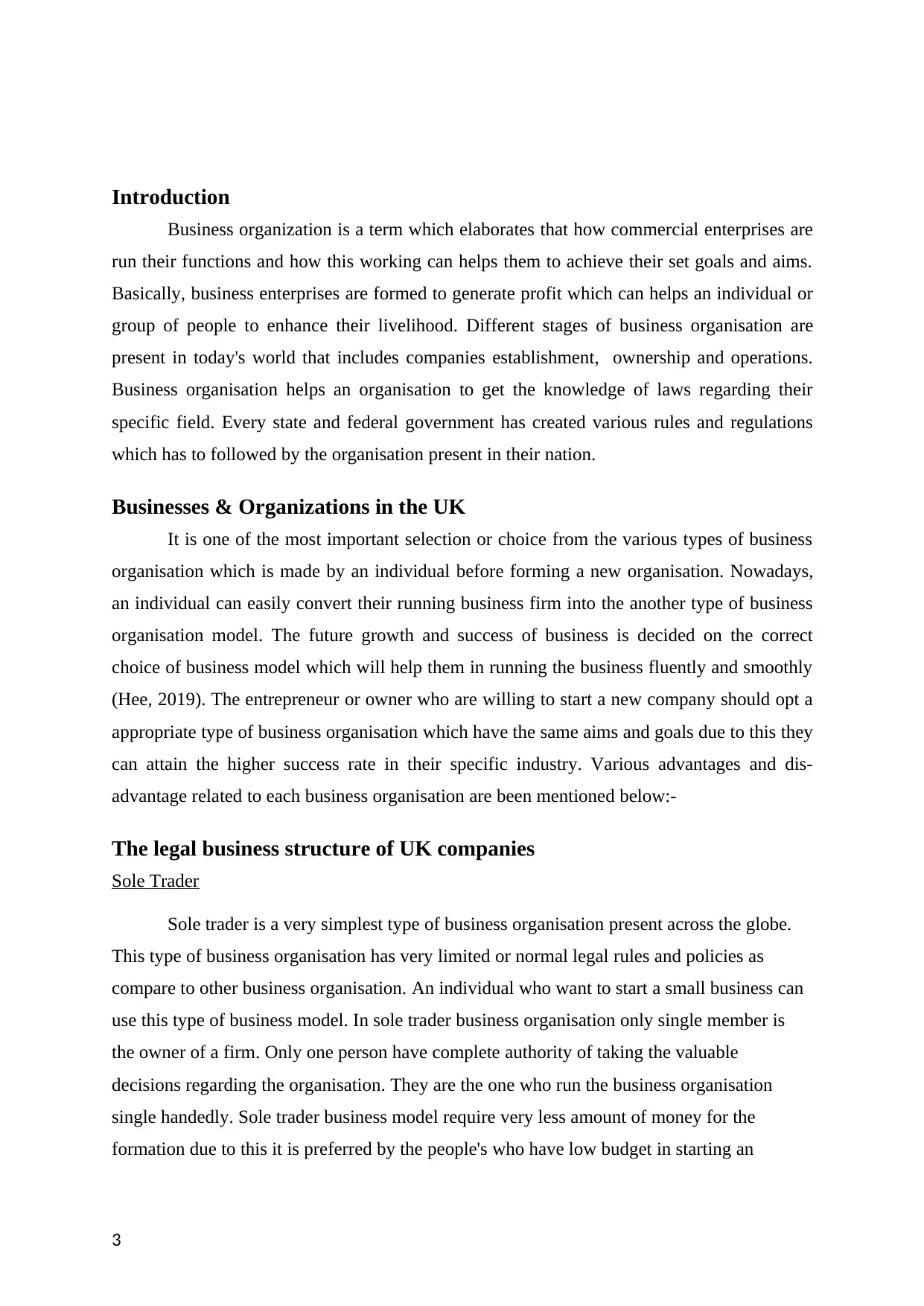
Introduction
Business organization is a term which elaborates that how commercial enterprises are
run their functions and how this working can helps them to achieve their set goals and aims.
Basically, business enterprises are formed to generate profit which can helps an individual or
group of people to enhance their livelihood. Different stages of business organisation are
present in today's world that includes companies establishment, ownership and operations.
Business organisation helps an organisation to get the knowledge of laws regarding their
specific field. Every state and federal government has created various rules and regulations
which has to followed by the organisation present in their nation.
Businesses & Organizations in the UK
It is one of the most important selection or choice from the various types of business
organisation which is made by an individual before forming a new organisation. Nowadays,
an individual can easily convert their running business firm into the another type of business
organisation model. The future growth and success of business is decided on the correct
choice of business model which will help them in running the business fluently and smoothly
(Hee, 2019). The entrepreneur or owner who are willing to start a new company should opt a
appropriate type of business organisation which have the same aims and goals due to this they
can attain the higher success rate in their specific industry. Various advantages and dis-
advantage related to each business organisation are been mentioned below:-
The legal business structure of UK companies
Sole Trader
Sole trader is a very simplest type of business organisation present across the globe.
This type of business organisation has very limited or normal legal rules and policies as
compare to other business organisation. An individual who want to start a small business can
use this type of business model. In sole trader business organisation only single member is
the owner of a firm. Only one person have complete authority of taking the valuable
decisions regarding the organisation. They are the one who run the business organisation
single handedly. Sole trader business model require very less amount of money for the
formation due to this it is preferred by the people's who have low budget in starting an
3
Business organization is a term which elaborates that how commercial enterprises are
run their functions and how this working can helps them to achieve their set goals and aims.
Basically, business enterprises are formed to generate profit which can helps an individual or
group of people to enhance their livelihood. Different stages of business organisation are
present in today's world that includes companies establishment, ownership and operations.
Business organisation helps an organisation to get the knowledge of laws regarding their
specific field. Every state and federal government has created various rules and regulations
which has to followed by the organisation present in their nation.
Businesses & Organizations in the UK
It is one of the most important selection or choice from the various types of business
organisation which is made by an individual before forming a new organisation. Nowadays,
an individual can easily convert their running business firm into the another type of business
organisation model. The future growth and success of business is decided on the correct
choice of business model which will help them in running the business fluently and smoothly
(Hee, 2019). The entrepreneur or owner who are willing to start a new company should opt a
appropriate type of business organisation which have the same aims and goals due to this they
can attain the higher success rate in their specific industry. Various advantages and dis-
advantage related to each business organisation are been mentioned below:-
The legal business structure of UK companies
Sole Trader
Sole trader is a very simplest type of business organisation present across the globe.
This type of business organisation has very limited or normal legal rules and policies as
compare to other business organisation. An individual who want to start a small business can
use this type of business model. In sole trader business organisation only single member is
the owner of a firm. Only one person have complete authority of taking the valuable
decisions regarding the organisation. They are the one who run the business organisation
single handedly. Sole trader business model require very less amount of money for the
formation due to this it is preferred by the people's who have low budget in starting an
3
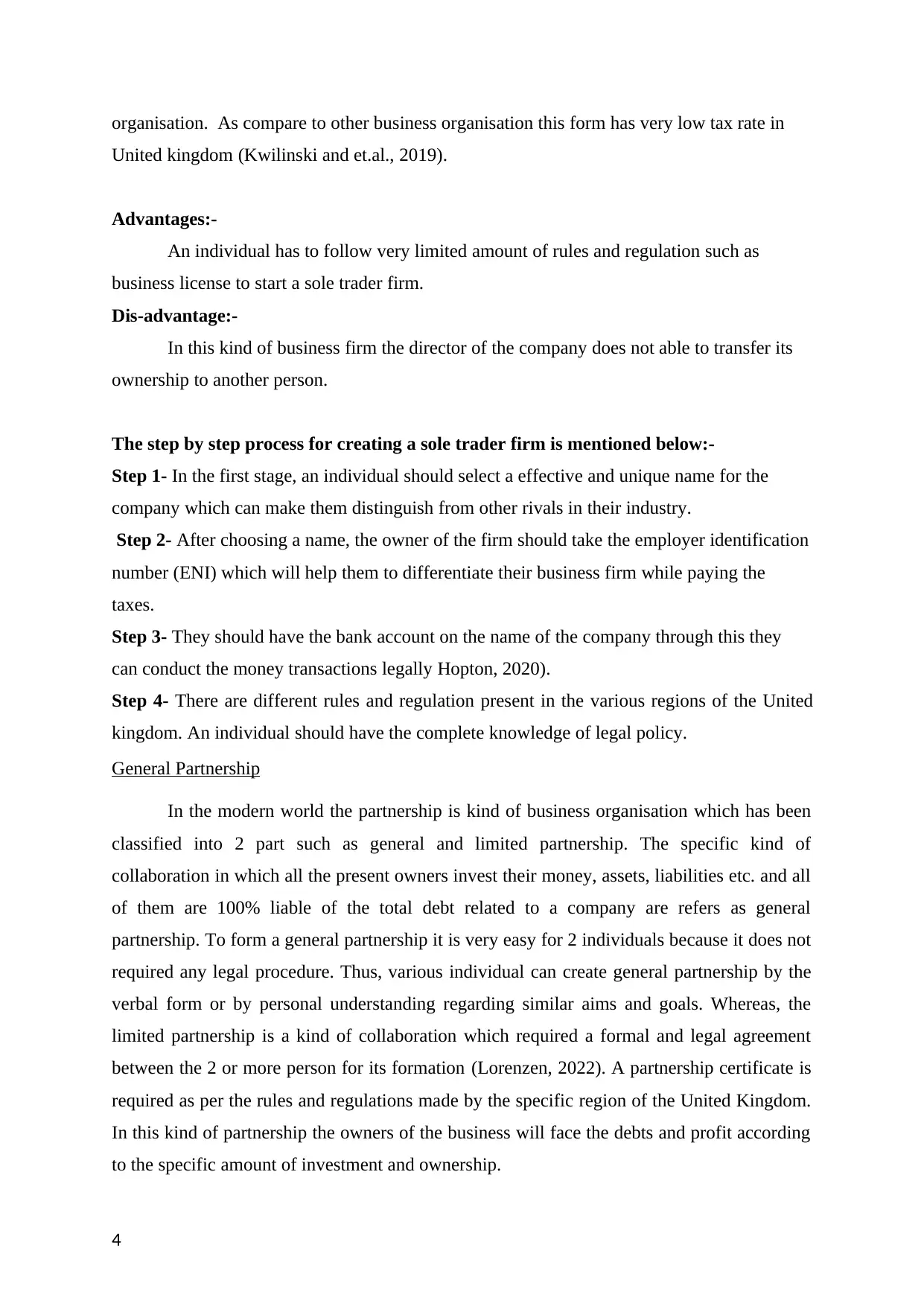
organisation. As compare to other business organisation this form has very low tax rate in
United kingdom (Kwilinski and et.al., 2019).
Advantages:-
An individual has to follow very limited amount of rules and regulation such as
business license to start a sole trader firm.
Dis-advantage:-
In this kind of business firm the director of the company does not able to transfer its
ownership to another person.
The step by step process for creating a sole trader firm is mentioned below:-
Step 1- In the first stage, an individual should select a effective and unique name for the
company which can make them distinguish from other rivals in their industry.
Step 2- After choosing a name, the owner of the firm should take the employer identification
number (ENI) which will help them to differentiate their business firm while paying the
taxes.
Step 3- They should have the bank account on the name of the company through this they
can conduct the money transactions legally Hopton, 2020).
Step 4- There are different rules and regulation present in the various regions of the United
kingdom. An individual should have the complete knowledge of legal policy.
General Partnership
In the modern world the partnership is kind of business organisation which has been
classified into 2 part such as general and limited partnership. The specific kind of
collaboration in which all the present owners invest their money, assets, liabilities etc. and all
of them are 100% liable of the total debt related to a company are refers as general
partnership. To form a general partnership it is very easy for 2 individuals because it does not
required any legal procedure. Thus, various individual can create general partnership by the
verbal form or by personal understanding regarding similar aims and goals. Whereas, the
limited partnership is a kind of collaboration which required a formal and legal agreement
between the 2 or more person for its formation (Lorenzen, 2022). A partnership certificate is
required as per the rules and regulations made by the specific region of the United Kingdom.
In this kind of partnership the owners of the business will face the debts and profit according
to the specific amount of investment and ownership.
4
United kingdom (Kwilinski and et.al., 2019).
Advantages:-
An individual has to follow very limited amount of rules and regulation such as
business license to start a sole trader firm.
Dis-advantage:-
In this kind of business firm the director of the company does not able to transfer its
ownership to another person.
The step by step process for creating a sole trader firm is mentioned below:-
Step 1- In the first stage, an individual should select a effective and unique name for the
company which can make them distinguish from other rivals in their industry.
Step 2- After choosing a name, the owner of the firm should take the employer identification
number (ENI) which will help them to differentiate their business firm while paying the
taxes.
Step 3- They should have the bank account on the name of the company through this they
can conduct the money transactions legally Hopton, 2020).
Step 4- There are different rules and regulation present in the various regions of the United
kingdom. An individual should have the complete knowledge of legal policy.
General Partnership
In the modern world the partnership is kind of business organisation which has been
classified into 2 part such as general and limited partnership. The specific kind of
collaboration in which all the present owners invest their money, assets, liabilities etc. and all
of them are 100% liable of the total debt related to a company are refers as general
partnership. To form a general partnership it is very easy for 2 individuals because it does not
required any legal procedure. Thus, various individual can create general partnership by the
verbal form or by personal understanding regarding similar aims and goals. Whereas, the
limited partnership is a kind of collaboration which required a formal and legal agreement
between the 2 or more person for its formation (Lorenzen, 2022). A partnership certificate is
required as per the rules and regulations made by the specific region of the United Kingdom.
In this kind of partnership the owners of the business will face the debts and profit according
to the specific amount of investment and ownership.
4
Secure Best Marks with AI Grader
Need help grading? Try our AI Grader for instant feedback on your assignments.
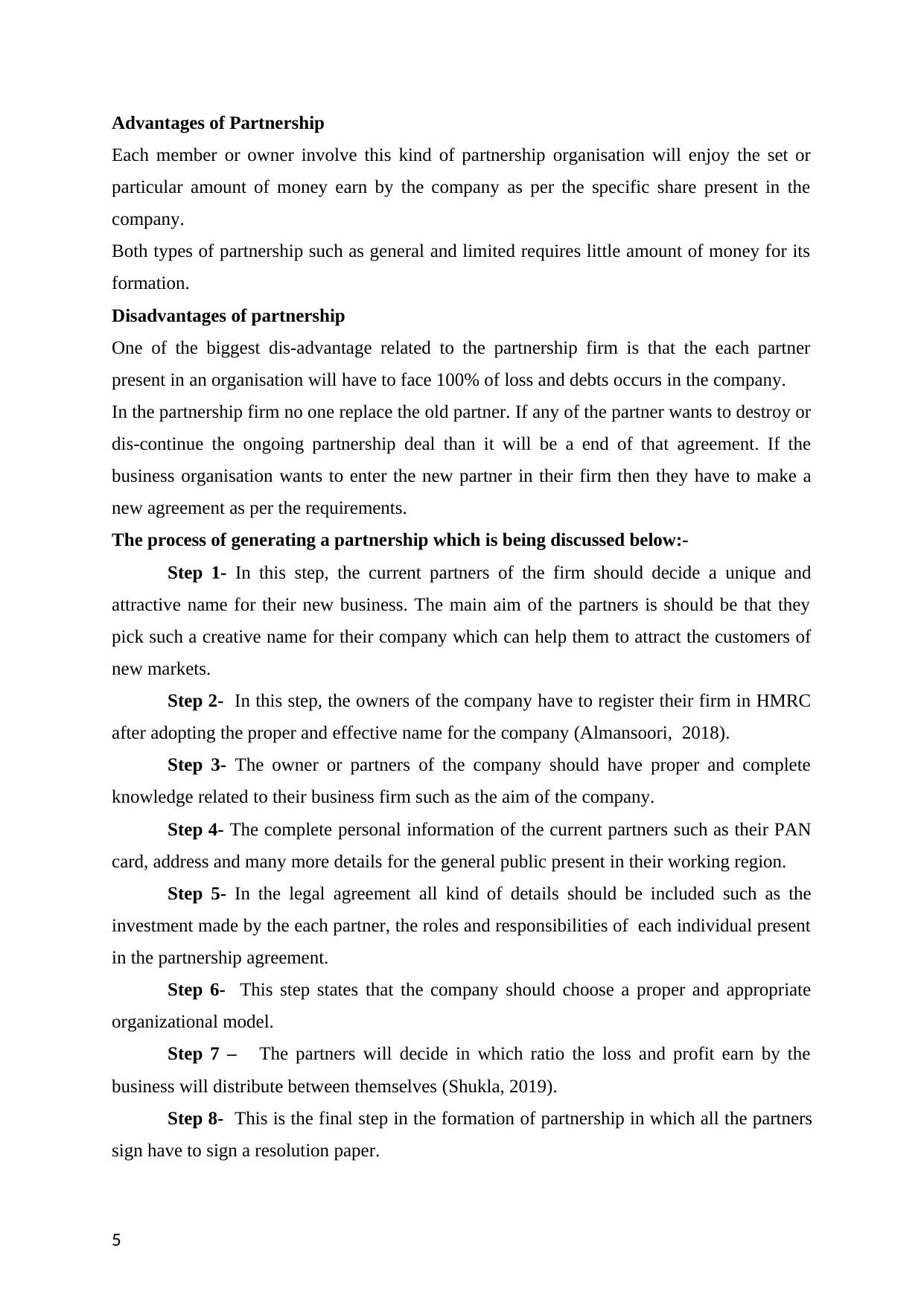
Advantages of Partnership
Each member or owner involve this kind of partnership organisation will enjoy the set or
particular amount of money earn by the company as per the specific share present in the
company.
Both types of partnership such as general and limited requires little amount of money for its
formation.
Disadvantages of partnership
One of the biggest dis-advantage related to the partnership firm is that the each partner
present in an organisation will have to face 100% of loss and debts occurs in the company.
In the partnership firm no one replace the old partner. If any of the partner wants to destroy or
dis-continue the ongoing partnership deal than it will be a end of that agreement. If the
business organisation wants to enter the new partner in their firm then they have to make a
new agreement as per the requirements.
The process of generating a partnership which is being discussed below:-
Step 1- In this step, the current partners of the firm should decide a unique and
attractive name for their new business. The main aim of the partners is should be that they
pick such a creative name for their company which can help them to attract the customers of
new markets.
Step 2- In this step, the owners of the company have to register their firm in HMRC
after adopting the proper and effective name for the company (Almansoori, 2018).
Step 3- The owner or partners of the company should have proper and complete
knowledge related to their business firm such as the aim of the company.
Step 4- The complete personal information of the current partners such as their PAN
card, address and many more details for the general public present in their working region.
Step 5- In the legal agreement all kind of details should be included such as the
investment made by the each partner, the roles and responsibilities of each individual present
in the partnership agreement.
Step 6- This step states that the company should choose a proper and appropriate
organizational model.
Step 7 – The partners will decide in which ratio the loss and profit earn by the
business will distribute between themselves (Shukla, 2019).
Step 8- This is the final step in the formation of partnership in which all the partners
sign have to sign a resolution paper.
5
Each member or owner involve this kind of partnership organisation will enjoy the set or
particular amount of money earn by the company as per the specific share present in the
company.
Both types of partnership such as general and limited requires little amount of money for its
formation.
Disadvantages of partnership
One of the biggest dis-advantage related to the partnership firm is that the each partner
present in an organisation will have to face 100% of loss and debts occurs in the company.
In the partnership firm no one replace the old partner. If any of the partner wants to destroy or
dis-continue the ongoing partnership deal than it will be a end of that agreement. If the
business organisation wants to enter the new partner in their firm then they have to make a
new agreement as per the requirements.
The process of generating a partnership which is being discussed below:-
Step 1- In this step, the current partners of the firm should decide a unique and
attractive name for their new business. The main aim of the partners is should be that they
pick such a creative name for their company which can help them to attract the customers of
new markets.
Step 2- In this step, the owners of the company have to register their firm in HMRC
after adopting the proper and effective name for the company (Almansoori, 2018).
Step 3- The owner or partners of the company should have proper and complete
knowledge related to their business firm such as the aim of the company.
Step 4- The complete personal information of the current partners such as their PAN
card, address and many more details for the general public present in their working region.
Step 5- In the legal agreement all kind of details should be included such as the
investment made by the each partner, the roles and responsibilities of each individual present
in the partnership agreement.
Step 6- This step states that the company should choose a proper and appropriate
organizational model.
Step 7 – The partners will decide in which ratio the loss and profit earn by the
business will distribute between themselves (Shukla, 2019).
Step 8- This is the final step in the formation of partnership in which all the partners
sign have to sign a resolution paper.
5
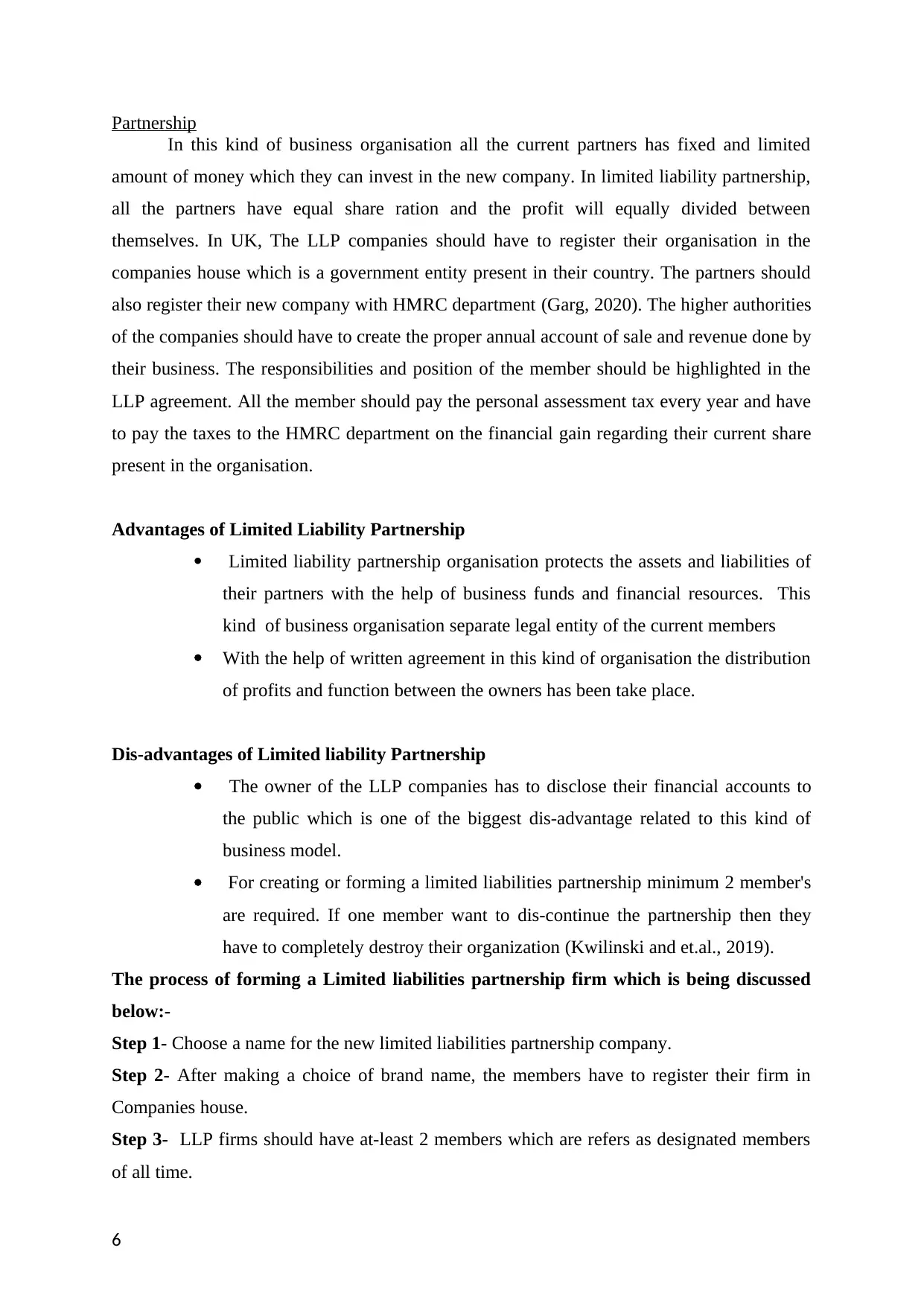
Partnership
In this kind of business organisation all the current partners has fixed and limited
amount of money which they can invest in the new company. In limited liability partnership,
all the partners have equal share ration and the profit will equally divided between
themselves. In UK, The LLP companies should have to register their organisation in the
companies house which is a government entity present in their country. The partners should
also register their new company with HMRC department (Garg, 2020). The higher authorities
of the companies should have to create the proper annual account of sale and revenue done by
their business. The responsibilities and position of the member should be highlighted in the
LLP agreement. All the member should pay the personal assessment tax every year and have
to pay the taxes to the HMRC department on the financial gain regarding their current share
present in the organisation.
Advantages of Limited Liability Partnership
Limited liability partnership organisation protects the assets and liabilities of
their partners with the help of business funds and financial resources. This
kind of business organisation separate legal entity of the current members
With the help of written agreement in this kind of organisation the distribution
of profits and function between the owners has been take place.
Dis-advantages of Limited liability Partnership
The owner of the LLP companies has to disclose their financial accounts to
the public which is one of the biggest dis-advantage related to this kind of
business model.
For creating or forming a limited liabilities partnership minimum 2 member's
are required. If one member want to dis-continue the partnership then they
have to completely destroy their organization (Kwilinski and et.al., 2019).
The process of forming a Limited liabilities partnership firm which is being discussed
below:-
Step 1- Choose a name for the new limited liabilities partnership company.
Step 2- After making a choice of brand name, the members have to register their firm in
Companies house.
Step 3- LLP firms should have at-least 2 members which are refers as designated members
of all time.
6
In this kind of business organisation all the current partners has fixed and limited
amount of money which they can invest in the new company. In limited liability partnership,
all the partners have equal share ration and the profit will equally divided between
themselves. In UK, The LLP companies should have to register their organisation in the
companies house which is a government entity present in their country. The partners should
also register their new company with HMRC department (Garg, 2020). The higher authorities
of the companies should have to create the proper annual account of sale and revenue done by
their business. The responsibilities and position of the member should be highlighted in the
LLP agreement. All the member should pay the personal assessment tax every year and have
to pay the taxes to the HMRC department on the financial gain regarding their current share
present in the organisation.
Advantages of Limited Liability Partnership
Limited liability partnership organisation protects the assets and liabilities of
their partners with the help of business funds and financial resources. This
kind of business organisation separate legal entity of the current members
With the help of written agreement in this kind of organisation the distribution
of profits and function between the owners has been take place.
Dis-advantages of Limited liability Partnership
The owner of the LLP companies has to disclose their financial accounts to
the public which is one of the biggest dis-advantage related to this kind of
business model.
For creating or forming a limited liabilities partnership minimum 2 member's
are required. If one member want to dis-continue the partnership then they
have to completely destroy their organization (Kwilinski and et.al., 2019).
The process of forming a Limited liabilities partnership firm which is being discussed
below:-
Step 1- Choose a name for the new limited liabilities partnership company.
Step 2- After making a choice of brand name, the members have to register their firm in
Companies house.
Step 3- LLP firms should have at-least 2 members which are refers as designated members
of all time.
6
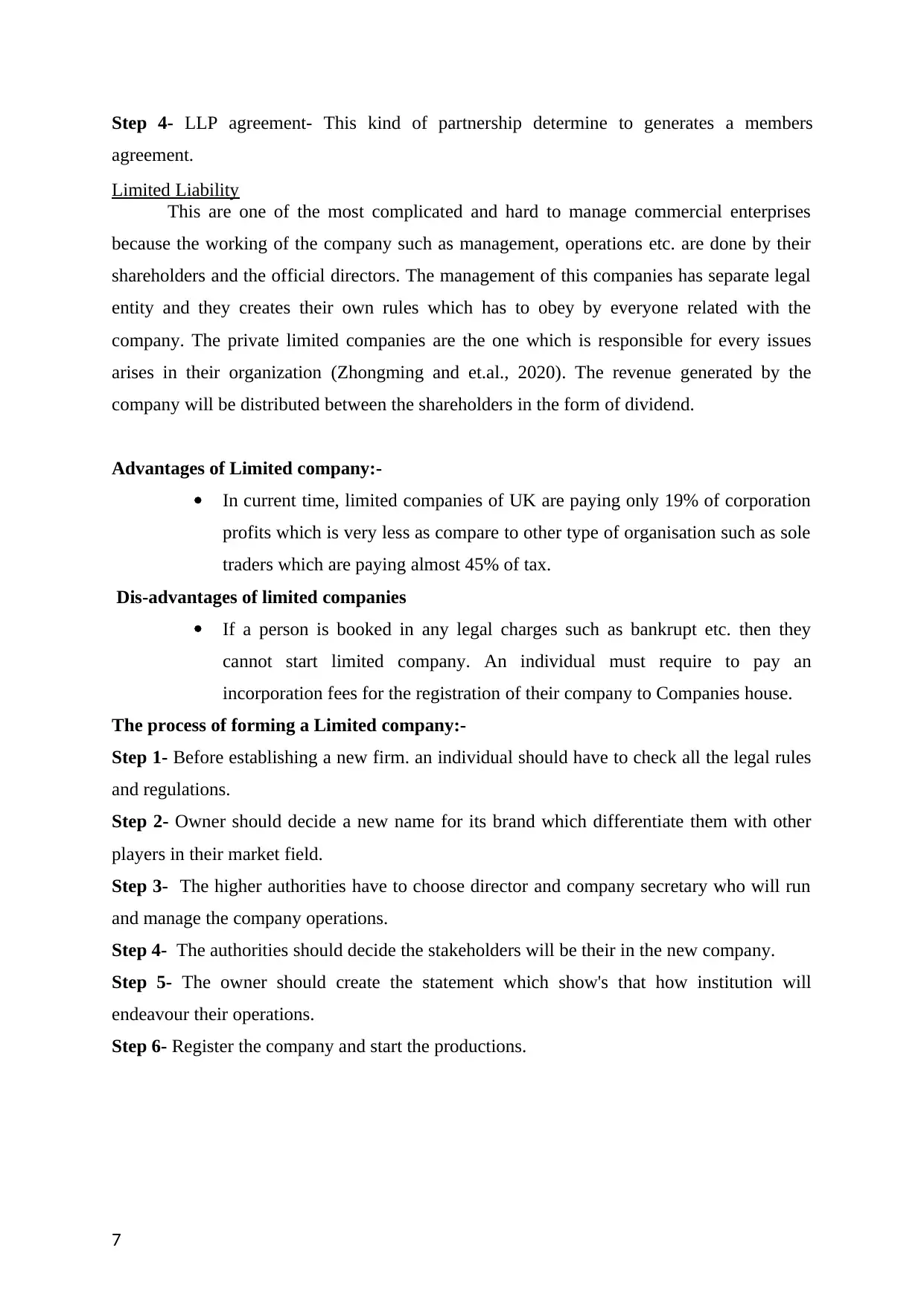
Step 4- LLP agreement- This kind of partnership determine to generates a members
agreement.
Limited Liability
This are one of the most complicated and hard to manage commercial enterprises
because the working of the company such as management, operations etc. are done by their
shareholders and the official directors. The management of this companies has separate legal
entity and they creates their own rules which has to obey by everyone related with the
company. The private limited companies are the one which is responsible for every issues
arises in their organization (Zhongming and et.al., 2020). The revenue generated by the
company will be distributed between the shareholders in the form of dividend.
Advantages of Limited company:-
In current time, limited companies of UK are paying only 19% of corporation
profits which is very less as compare to other type of organisation such as sole
traders which are paying almost 45% of tax.
Dis-advantages of limited companies
If a person is booked in any legal charges such as bankrupt etc. then they
cannot start limited company. An individual must require to pay an
incorporation fees for the registration of their company to Companies house.
The process of forming a Limited company:-
Step 1- Before establishing a new firm. an individual should have to check all the legal rules
and regulations.
Step 2- Owner should decide a new name for its brand which differentiate them with other
players in their market field.
Step 3- The higher authorities have to choose director and company secretary who will run
and manage the company operations.
Step 4- The authorities should decide the stakeholders will be their in the new company.
Step 5- The owner should create the statement which show's that how institution will
endeavour their operations.
Step 6- Register the company and start the productions.
7
agreement.
Limited Liability
This are one of the most complicated and hard to manage commercial enterprises
because the working of the company such as management, operations etc. are done by their
shareholders and the official directors. The management of this companies has separate legal
entity and they creates their own rules which has to obey by everyone related with the
company. The private limited companies are the one which is responsible for every issues
arises in their organization (Zhongming and et.al., 2020). The revenue generated by the
company will be distributed between the shareholders in the form of dividend.
Advantages of Limited company:-
In current time, limited companies of UK are paying only 19% of corporation
profits which is very less as compare to other type of organisation such as sole
traders which are paying almost 45% of tax.
Dis-advantages of limited companies
If a person is booked in any legal charges such as bankrupt etc. then they
cannot start limited company. An individual must require to pay an
incorporation fees for the registration of their company to Companies house.
The process of forming a Limited company:-
Step 1- Before establishing a new firm. an individual should have to check all the legal rules
and regulations.
Step 2- Owner should decide a new name for its brand which differentiate them with other
players in their market field.
Step 3- The higher authorities have to choose director and company secretary who will run
and manage the company operations.
Step 4- The authorities should decide the stakeholders will be their in the new company.
Step 5- The owner should create the statement which show's that how institution will
endeavour their operations.
Step 6- Register the company and start the productions.
7
Paraphrase This Document
Need a fresh take? Get an instant paraphrase of this document with our AI Paraphraser
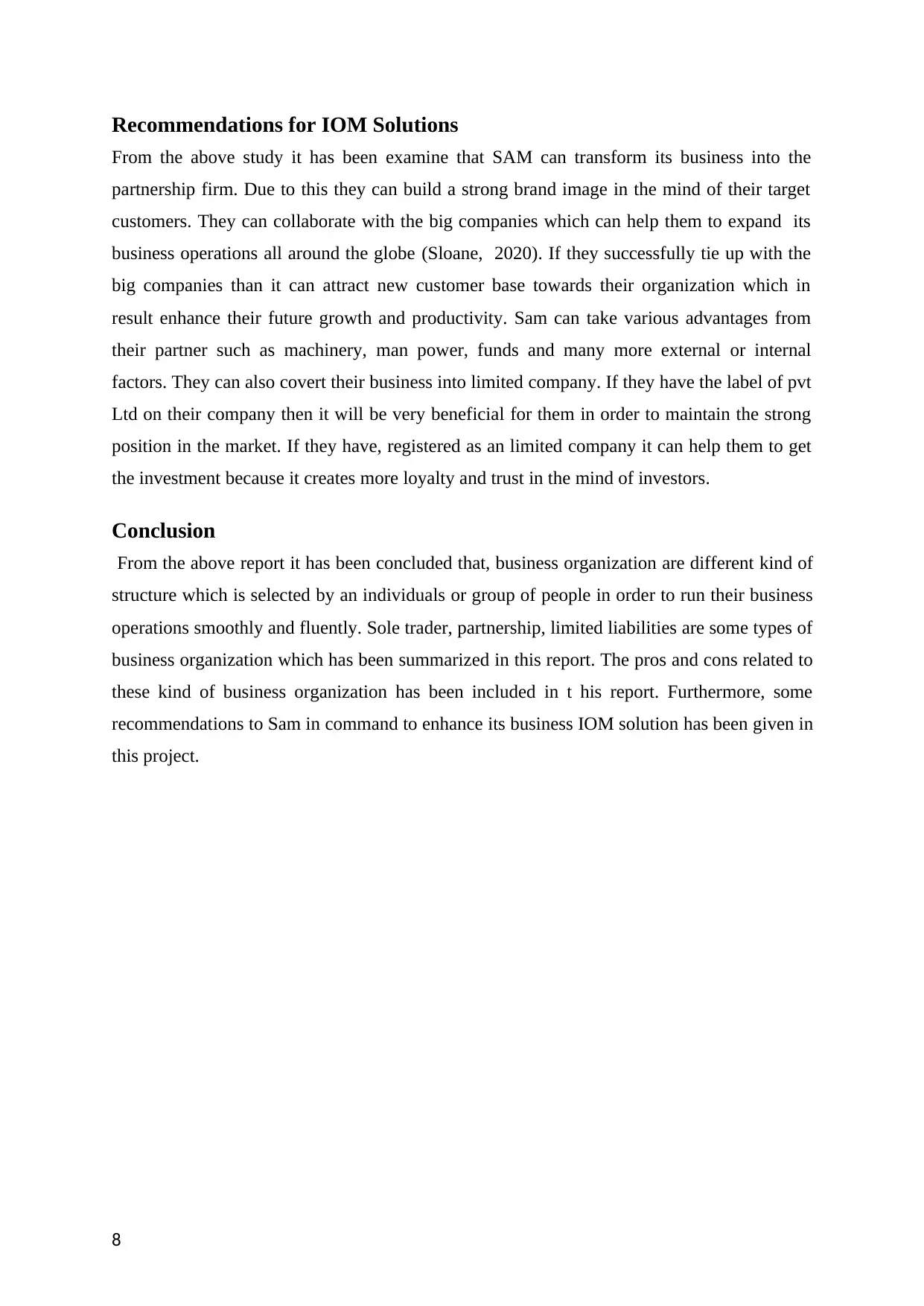
Recommendations for IOM Solutions
From the above study it has been examine that SAM can transform its business into the
partnership firm. Due to this they can build a strong brand image in the mind of their target
customers. They can collaborate with the big companies which can help them to expand its
business operations all around the globe (Sloane, 2020). If they successfully tie up with the
big companies than it can attract new customer base towards their organization which in
result enhance their future growth and productivity. Sam can take various advantages from
their partner such as machinery, man power, funds and many more external or internal
factors. They can also covert their business into limited company. If they have the label of pvt
Ltd on their company then it will be very beneficial for them in order to maintain the strong
position in the market. If they have, registered as an limited company it can help them to get
the investment because it creates more loyalty and trust in the mind of investors.
Conclusion
From the above report it has been concluded that, business organization are different kind of
structure which is selected by an individuals or group of people in order to run their business
operations smoothly and fluently. Sole trader, partnership, limited liabilities are some types of
business organization which has been summarized in this report. The pros and cons related to
these kind of business organization has been included in t his report. Furthermore, some
recommendations to Sam in command to enhance its business IOM solution has been given in
this project.
8
From the above study it has been examine that SAM can transform its business into the
partnership firm. Due to this they can build a strong brand image in the mind of their target
customers. They can collaborate with the big companies which can help them to expand its
business operations all around the globe (Sloane, 2020). If they successfully tie up with the
big companies than it can attract new customer base towards their organization which in
result enhance their future growth and productivity. Sam can take various advantages from
their partner such as machinery, man power, funds and many more external or internal
factors. They can also covert their business into limited company. If they have the label of pvt
Ltd on their company then it will be very beneficial for them in order to maintain the strong
position in the market. If they have, registered as an limited company it can help them to get
the investment because it creates more loyalty and trust in the mind of investors.
Conclusion
From the above report it has been concluded that, business organization are different kind of
structure which is selected by an individuals or group of people in order to run their business
operations smoothly and fluently. Sole trader, partnership, limited liabilities are some types of
business organization which has been summarized in this report. The pros and cons related to
these kind of business organization has been included in t his report. Furthermore, some
recommendations to Sam in command to enhance its business IOM solution has been given in
this project.
8
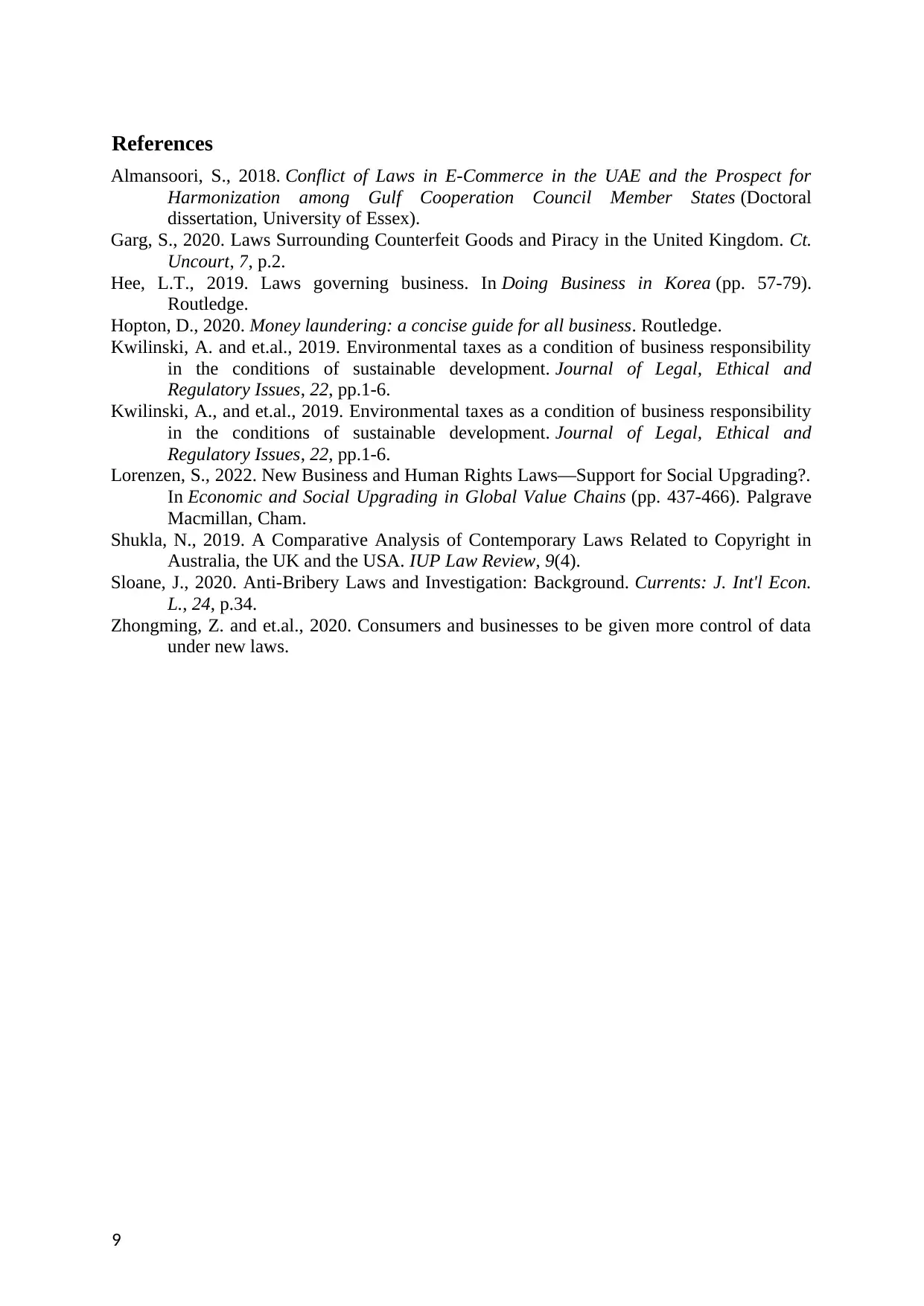
References
Almansoori, S., 2018. Conflict of Laws in E-Commerce in the UAE and the Prospect for
Harmonization among Gulf Cooperation Council Member States (Doctoral
dissertation, University of Essex).
Garg, S., 2020. Laws Surrounding Counterfeit Goods and Piracy in the United Kingdom. Ct.
Uncourt, 7, p.2.
Hee, L.T., 2019. Laws governing business. In Doing Business in Korea (pp. 57-79).
Routledge.
Hopton, D., 2020. Money laundering: a concise guide for all business. Routledge.
Kwilinski, A. and et.al., 2019. Environmental taxes as a condition of business responsibility
in the conditions of sustainable development. Journal of Legal, Ethical and
Regulatory Issues, 22, pp.1-6.
Kwilinski, A., and et.al., 2019. Environmental taxes as a condition of business responsibility
in the conditions of sustainable development. Journal of Legal, Ethical and
Regulatory Issues, 22, pp.1-6.
Lorenzen, S., 2022. New Business and Human Rights Laws—Support for Social Upgrading?.
In Economic and Social Upgrading in Global Value Chains (pp. 437-466). Palgrave
Macmillan, Cham.
Shukla, N., 2019. A Comparative Analysis of Contemporary Laws Related to Copyright in
Australia, the UK and the USA. IUP Law Review, 9(4).
Sloane, J., 2020. Anti-Bribery Laws and Investigation: Background. Currents: J. Int'l Econ.
L., 24, p.34.
Zhongming, Z. and et.al., 2020. Consumers and businesses to be given more control of data
under new laws.
9
Almansoori, S., 2018. Conflict of Laws in E-Commerce in the UAE and the Prospect for
Harmonization among Gulf Cooperation Council Member States (Doctoral
dissertation, University of Essex).
Garg, S., 2020. Laws Surrounding Counterfeit Goods and Piracy in the United Kingdom. Ct.
Uncourt, 7, p.2.
Hee, L.T., 2019. Laws governing business. In Doing Business in Korea (pp. 57-79).
Routledge.
Hopton, D., 2020. Money laundering: a concise guide for all business. Routledge.
Kwilinski, A. and et.al., 2019. Environmental taxes as a condition of business responsibility
in the conditions of sustainable development. Journal of Legal, Ethical and
Regulatory Issues, 22, pp.1-6.
Kwilinski, A., and et.al., 2019. Environmental taxes as a condition of business responsibility
in the conditions of sustainable development. Journal of Legal, Ethical and
Regulatory Issues, 22, pp.1-6.
Lorenzen, S., 2022. New Business and Human Rights Laws—Support for Social Upgrading?.
In Economic and Social Upgrading in Global Value Chains (pp. 437-466). Palgrave
Macmillan, Cham.
Shukla, N., 2019. A Comparative Analysis of Contemporary Laws Related to Copyright in
Australia, the UK and the USA. IUP Law Review, 9(4).
Sloane, J., 2020. Anti-Bribery Laws and Investigation: Background. Currents: J. Int'l Econ.
L., 24, p.34.
Zhongming, Z. and et.al., 2020. Consumers and businesses to be given more control of data
under new laws.
9
1 out of 9
Related Documents
Your All-in-One AI-Powered Toolkit for Academic Success.
+13062052269
info@desklib.com
Available 24*7 on WhatsApp / Email
![[object Object]](/_next/static/media/star-bottom.7253800d.svg)
Unlock your academic potential
© 2024 | Zucol Services PVT LTD | All rights reserved.



